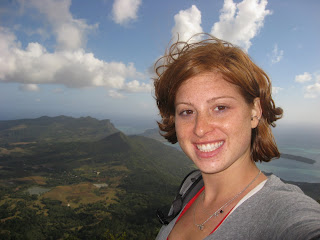 Ganesha Chaturthi is a Hindu festival celebrating the birthday of the Lord Ganesha (also spelled Ganesh), the elephant-headed son of Shiva and Parvati. Ganesha is widely revered as the Remover of Obstacles. To celebrate Ganesha, communities come together to make offerings of fruit and money to the deity and pray that he will remove obstacles in their lives for the upcoming year. I was able to observe and participate in this celebration. On Sunday night, I went to a friend of a friend's home where about 80 friends and family members had gathered to eat and pray. In the main room was an alter with a large statue of Ganesha. As people arrived, they took off their
Ganesha Chaturthi is a Hindu festival celebrating the birthday of the Lord Ganesha (also spelled Ganesh), the elephant-headed son of Shiva and Parvati. Ganesha is widely revered as the Remover of Obstacles. To celebrate Ganesha, communities come together to make offerings of fruit and money to the deity and pray that he will remove obstacles in their lives for the upcoming year. I was able to observe and participate in this celebration. On Sunday night, I went to a friend of a friend's home where about 80 friends and family members had gathered to eat and pray. In the main room was an alter with a large statue of Ganesha. As people arrived, they took off their shoes, entered the room and waited to give their offerings of fruit and prayers to Ganesha. In return for your offering, you receive some fruit back. The room smelled heavily of incense and sweetness with a touch of coconut. After our prayers were offered, we sat down outside in plastic lawn chairs set up in rows facing a stage where a dozen or so men and women sat singing prayers and playing a harmonium, various bells and drums. The tunes were rhythmic and slightly somber but people swayed and sang along creating a palpable spirit of positive energy. After the singing came dancing. Two men sat facing each other, drums on laps,
shoes, entered the room and waited to give their offerings of fruit and prayers to Ganesha. In return for your offering, you receive some fruit back. The room smelled heavily of incense and sweetness with a touch of coconut. After our prayers were offered, we sat down outside in plastic lawn chairs set up in rows facing a stage where a dozen or so men and women sat singing prayers and playing a harmonium, various bells and drums. The tunes were rhythmic and slightly somber but people swayed and sang along creating a palpable spirit of positive energy. After the singing came dancing. Two men sat facing each other, drums on laps,  playing both with each other and against each other to create a sensational beat. The other men and women put down their instruments and began a call-and-response sort of singing as they danced counter-clockwise around them. Not long into the dancing I was called for to come on stage and join the circular dance and song. The rhythm of the drums echoed through the floorboards to my feet making all of our movements as fluid as the songs themselves.
playing both with each other and against each other to create a sensational beat. The other men and women put down their instruments and began a call-and-response sort of singing as they danced counter-clockwise around them. Not long into the dancing I was called for to come on stage and join the circular dance and song. The rhythm of the drums echoed through the floorboards to my feet making all of our movements as fluid as the songs themselves.After dancing, we went out to the back yard to sit at a long picnic table under a tent and were served rice and Dal and all sorts of other vegetarian Indian dishes that I need to learn the
 names of. Being exhausted from hiking all day, I opted out of coffee, thanked my hosts and headed home.
names of. Being exhausted from hiking all day, I opted out of coffee, thanked my hosts and headed home.Monday, the celebration and prayer continues much in the same way for the morning and afternoon. In the late afternoon, the statue of Ganesha is either carried or transported on a vehicle to a body of water. Everyone follows the statue in a colorful procession. Around 5:30 pm the statues are brought into the water, dunked three times and on the third time fully sunk where they are left to melt back into the earth. As the statue sinks last prayers are sung out as this is the moment when Ganesha is listening to all of the prayers so that he can help to remove obstacles in this coming year. I watched from a beach in Flic en Flac where multiple processions had met up to make a great big crowd. The statues were lined on wooden tables and were brought one by one into the ocean. By 6:30 all of the statues had been put in the sea and the festival was officially over. The beach, which only an hour before had been filled with colorful saris, magenta paint, flowers, candles, fruit and beautifully decorated statues, was dark and quite but the feeling of prayer and celebration remained and a cheshire cat moon smiled down.











